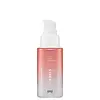What's inside
What's inside
 Key Ingredients
Key Ingredients

 Benefits
Benefits

 Concerns
Concerns

 Ingredients Side-by-side
Ingredients Side-by-side

Water
Skin ConditioningAscorbic Acid 20%
AntioxidantFerulic Acid 2%
AntimicrobialGlutathione
Tranexamic Acid
AstringentAlpha-Arbutin
AntioxidantAzelaic Acid
BufferingKojic Acid
Antioxidant4-Butylresorcinol
AntioxidantNiacinamide
SmoothingCitric Acid
BufferingDimethyl Sulfone
SolventArginine
MaskingMandelic Acid
AntimicrobialEthoxydiglycol
HumectantPropylene Glycol
HumectantPhenoxyethanol
PreservativeSodium Metabisulfite
AntioxidantWater
Skin ConditioningGlycerin
HumectantGlycolic Acid
BufferingGluconolactone
Skin ConditioningPropanediol
SolventCalophyllum Inophyllum Seed Oil
AntimicrobialSodium Hydroxide
BufferingTocopheryl Acetate
AntioxidantPyruvic Acid
MaskingLactobacillus Ferment
Skin ConditioningBisabolol
MaskingLeuconostoc/Radish Root Ferment Filtrate
AntimicrobialRosa Canina Seed Oil
EmollientLactic Acid
BufferingSalicylic Acid
MaskingNiacinamide
SmoothingSodium PCA
HumectantGlycyrrhiza Glabra Root Extract
BleachingButyrospermum Parkii Butter
Skin ConditioningCamellia Sinensis Leaf Extract
AntimicrobialCentella Asiatica Leaf Extract
Skin ConditioningHyaluronic Acid
HumectantSodium Hyaluronate Crosspolymer-3
HumectantPentapeptide-59
Skin ConditioningTetrahydrodiferuloylmethane
AntioxidantTetrahydrodemethoxydiferuloylmethane
AntioxidantTetrahydrobisdemethoxydiferuloylmethane
AntioxidantHydroxyethylcellulose
Emulsion StabilisingSclerotium Gum
Emulsion StabilisingMaltodextrin
AbsorbentSodium Gluconate
Skin ConditioningHydrogenated Lecithin
EmulsifyingDimethyl Sulfone
SolventEthylhexylglycerin
Skin ConditioningPotassium Sorbate
PreservativePhenethyl Alcohol
MaskingPhenoxyethanol
PreservativeWater, Glycerin, Glycolic Acid, Gluconolactone, Propanediol, Calophyllum Inophyllum Seed Oil, Sodium Hydroxide, Tocopheryl Acetate, Pyruvic Acid, Lactobacillus Ferment, Bisabolol, Leuconostoc/Radish Root Ferment Filtrate, Rosa Canina Seed Oil, Lactic Acid, Salicylic Acid, Niacinamide, Sodium PCA, Glycyrrhiza Glabra Root Extract, Butyrospermum Parkii Butter, Camellia Sinensis Leaf Extract, Centella Asiatica Leaf Extract, Hyaluronic Acid, Sodium Hyaluronate Crosspolymer-3, Pentapeptide-59, Tetrahydrodiferuloylmethane, Tetrahydrodemethoxydiferuloylmethane, Tetrahydrobisdemethoxydiferuloylmethane, Hydroxyethylcellulose, Sclerotium Gum, Maltodextrin, Sodium Gluconate, Hydrogenated Lecithin, Dimethyl Sulfone, Ethylhexylglycerin, Potassium Sorbate, Phenethyl Alcohol, Phenoxyethanol
 Reviews
Reviews

Ingredients Explained
These ingredients are found in both products.
Ingredients higher up in an ingredient list are typically present in a larger amount.
Dimethyl Sulfone is an organic compound that naturally contains sulfur. It is used as a solvent due to its stability. Solvents help mix and stabilize other ingredients.
Studies show taking Dimethyl Sulfone (also known as methylsulfonylmethane) orally may help reduce the depth of wrinkles. We recommend speaking with a professional if you have any questions or concerns about this ingredient.
Niacinamide is a multitasking form of vitamin B3 that strengthens the skin barrier, reduces pores and dark spots, regulates oil, and improves signs of aging.
And the best part? It's gentle and well-tolerated by most skin types, including sensitive and reactive skin.
You might have heard of "niacin flush", or the reddening of skin that causes itchiness. Niacinamide has not been found to cause this.
In very rare cases, some individuals may not be able to tolerate niacinamide at all or experience an allergic reaction to it.
If you are experiencing flaking, irritation, and dryness with this ingredient, be sure to double check all your products as this ingredient can be found in all categories of skincare.
When incorporating niacinamide into your routine, look out for concentration amounts. Typically, 5% niacinamide provides benefits such as fading dark spots. However, if you have sensitive skin, it is better to begin with a smaller concentration.
When you apply niacinamide to your skin, your body converts it into nicotinamide adenine dinucleotide (NAD). NAD is an essential coenzyme that is already found in your cells as "fuel" and powers countless biological processes.
In your skin, NAD helps repair cell damage, produce new healthy cells, support collagen production, strengthen the skin barrier, and fight environmental stressors (like UV and pollution).
Our natural NAD levels start to decline with age, leading to slower skin repair, visible aging, and a weaker skin barrier. By providing your skin niacinamide, you're recharging your skin's NAD levels. This leads to stronger, healthier, and younger looking skin.
Another name for vitamin B3 is nicotinamide. This vitamin is water-soluble and our bodies don't store it. We obtain Vitamin B3 from either food or skincare. Meat, fish, wheat, yeast, and leafy greens contain vitamin B3.
The type of niacinamide used in skincare is synthetically created.
Learn more about NiacinamidePhenoxyethanol is a preservative that has germicide, antimicrobial, and aromatic properties. Studies show that phenoxyethanol can prevent microbial growth. By itself, it has a scent that is similar to that of a rose.
It's often used in formulations along with Caprylyl Glycol to preserve the shelf life of products.
Water. It's the most common cosmetic ingredient of all. You'll usually see it at the top of ingredient lists, meaning that it makes up the largest part of the product.
So why is it so popular? Water most often acts as a solvent - this means that it helps dissolve other ingredients into the formulation.
You'll also recognize water as that liquid we all need to stay alive. If you see this, drink a glass of water. Stay hydrated!
Learn more about Water